PSY294 Lab Report: Memory Span Experiment - Murdoch University
VerifiedAdded on 2022/08/20
|13
|3100
|13
Report
AI Summary
This lab report details a memory span experiment conducted using CogLab5 with 129 undergraduate psychology students from Murdoch University. The study investigated the relationship between stimulus type (digits, letters, words) and memory span length. The report includes an introduction reviewing relevant literature on working memory and memory span, hypotheses, and a detailed methods section outlining the participants, materials, and procedure. Results are presented, including summary statistics and the outcomes of a Bonferroni test for multiple comparisons, demonstrating a significant relationship between stimulus type and memory span. The discussion section interprets the findings, relating them to existing theories of working memory and cognitive performance. The report adheres to the guidelines provided, including specific formatting requirements and references.
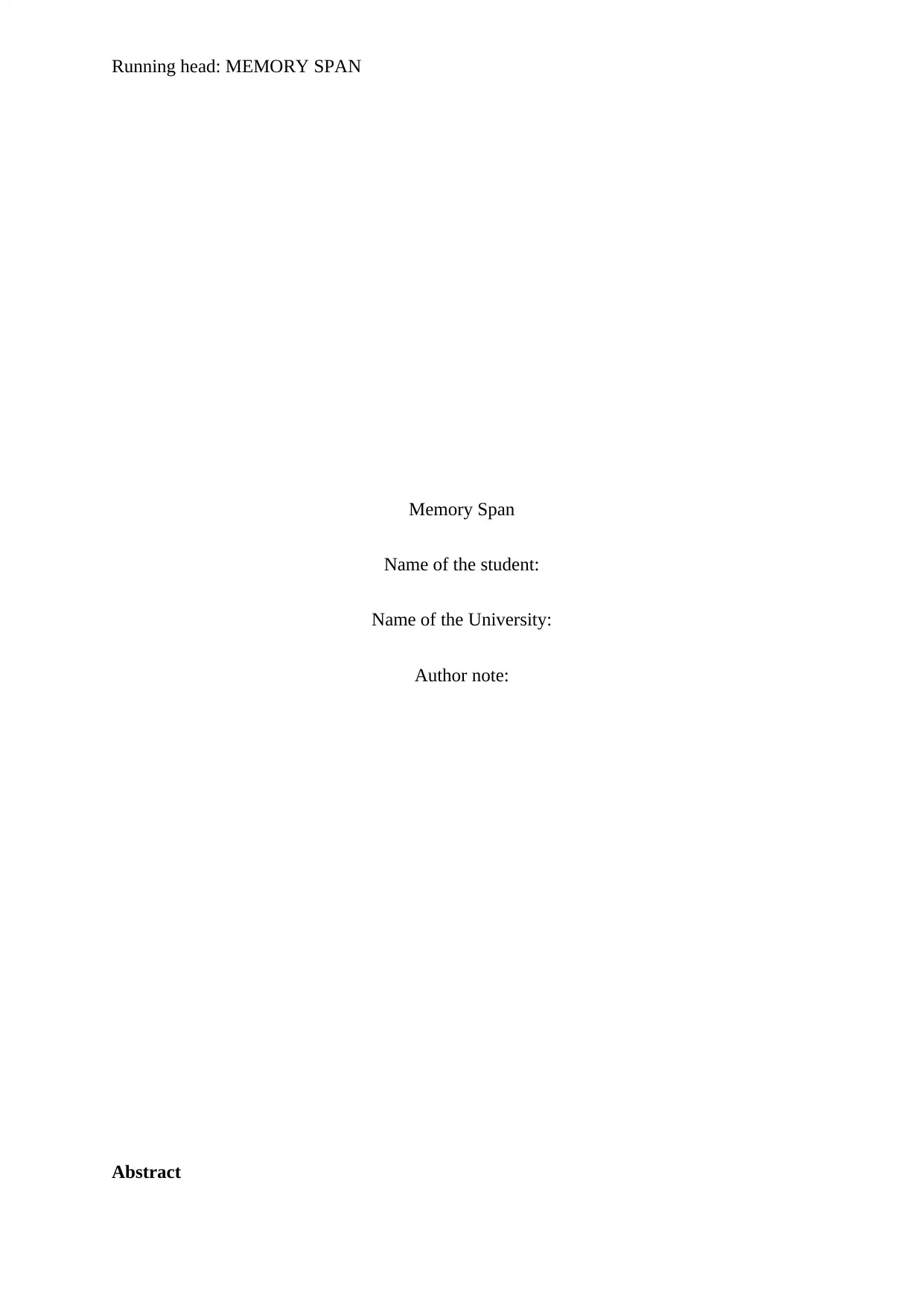
Running head: MEMORY SPAN
Memory Span
Name of the student:
Name of the University:
Author note:
Abstract
Memory Span
Name of the student:
Name of the University:
Author note:
Abstract
Paraphrase This Document
Need a fresh take? Get an instant paraphrase of this document with our AI Paraphraser
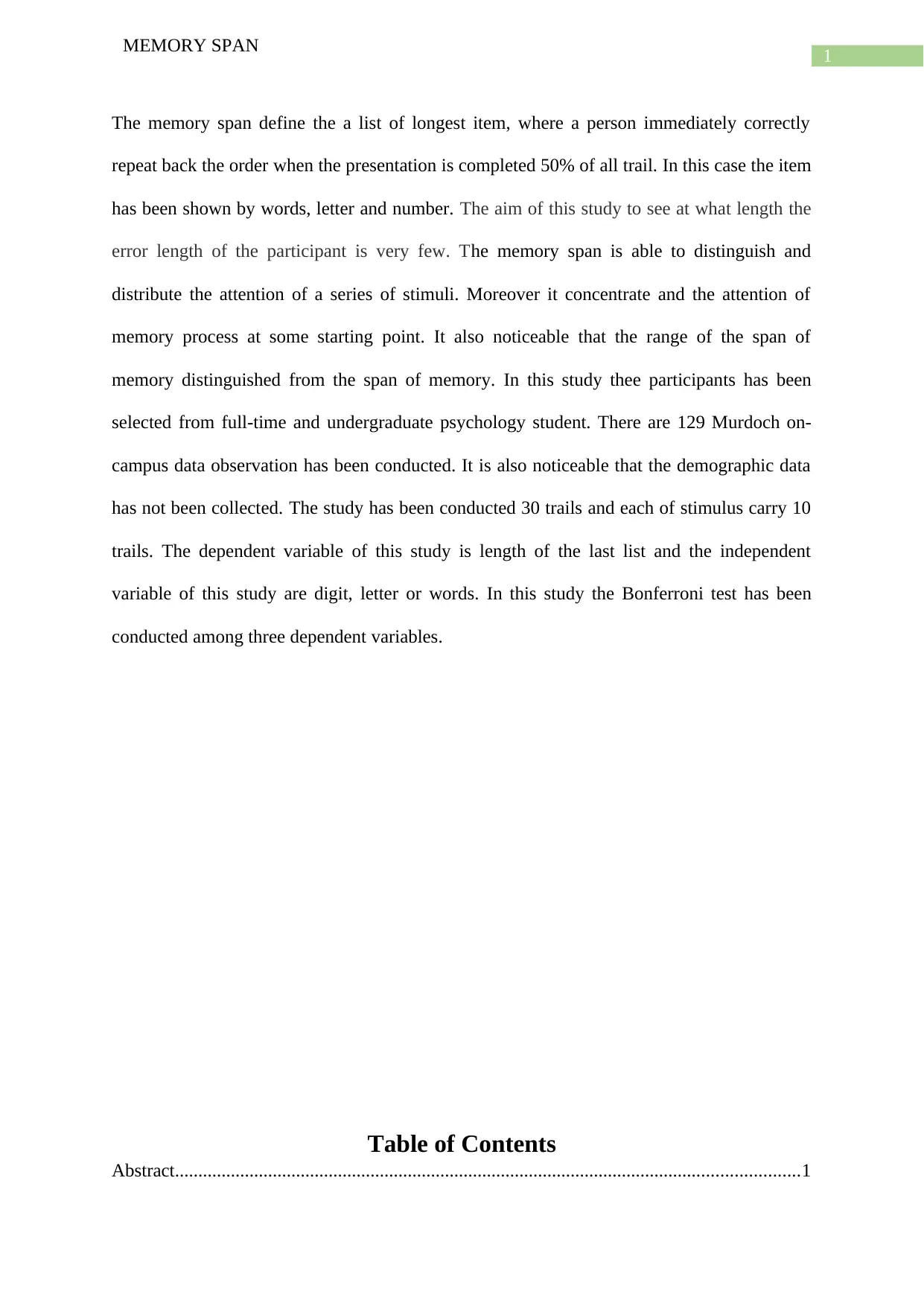
1
MEMORY SPAN
The memory span define the a list of longest item, where a person immediately correctly
repeat back the order when the presentation is completed 50% of all trail. In this case the item
has been shown by words, letter and number. The aim of this study to see at what length the
error length of the participant is very few. The memory span is able to distinguish and
distribute the attention of a series of stimuli. Moreover it concentrate and the attention of
memory process at some starting point. It also noticeable that the range of the span of
memory distinguished from the span of memory. In this study thee participants has been
selected from full-time and undergraduate psychology student. There are 129 Murdoch on-
campus data observation has been conducted. It is also noticeable that the demographic data
has not been collected. The study has been conducted 30 trails and each of stimulus carry 10
trails. The dependent variable of this study is length of the last list and the independent
variable of this study are digit, letter or words. In this study the Bonferroni test has been
conducted among three dependent variables.
Table of Contents
Abstract......................................................................................................................................1
MEMORY SPAN
The memory span define the a list of longest item, where a person immediately correctly
repeat back the order when the presentation is completed 50% of all trail. In this case the item
has been shown by words, letter and number. The aim of this study to see at what length the
error length of the participant is very few. The memory span is able to distinguish and
distribute the attention of a series of stimuli. Moreover it concentrate and the attention of
memory process at some starting point. It also noticeable that the range of the span of
memory distinguished from the span of memory. In this study thee participants has been
selected from full-time and undergraduate psychology student. There are 129 Murdoch on-
campus data observation has been conducted. It is also noticeable that the demographic data
has not been collected. The study has been conducted 30 trails and each of stimulus carry 10
trails. The dependent variable of this study is length of the last list and the independent
variable of this study are digit, letter or words. In this study the Bonferroni test has been
conducted among three dependent variables.
Table of Contents
Abstract......................................................................................................................................1

2
MEMORY SPAN
Introduction................................................................................................................................3
Literature review....................................................................................................................4
Hypotheses.............................................................................................................................4
Method.......................................................................................................................................5
Participants.............................................................................................................................5
Material and Procedure..........................................................................................................5
Results........................................................................................................................................6
Discussion................................................................................................................................10
References................................................................................................................................11
Introduction
The memory span define the a list of longest item, where a person immediately
correctly repeat back the order when the presentation is completed 50% of all trail. In this
case the item has been shown by words, letter and number (Baddeley & Lieberman, 2017).
MEMORY SPAN
Introduction................................................................................................................................3
Literature review....................................................................................................................4
Hypotheses.............................................................................................................................4
Method.......................................................................................................................................5
Participants.............................................................................................................................5
Material and Procedure..........................................................................................................5
Results........................................................................................................................................6
Discussion................................................................................................................................10
References................................................................................................................................11
Introduction
The memory span define the a list of longest item, where a person immediately
correctly repeat back the order when the presentation is completed 50% of all trail. In this
case the item has been shown by words, letter and number (Baddeley & Lieberman, 2017).
⊘ This is a preview!⊘
Do you want full access?
Subscribe today to unlock all pages.

Trusted by 1+ million students worldwide
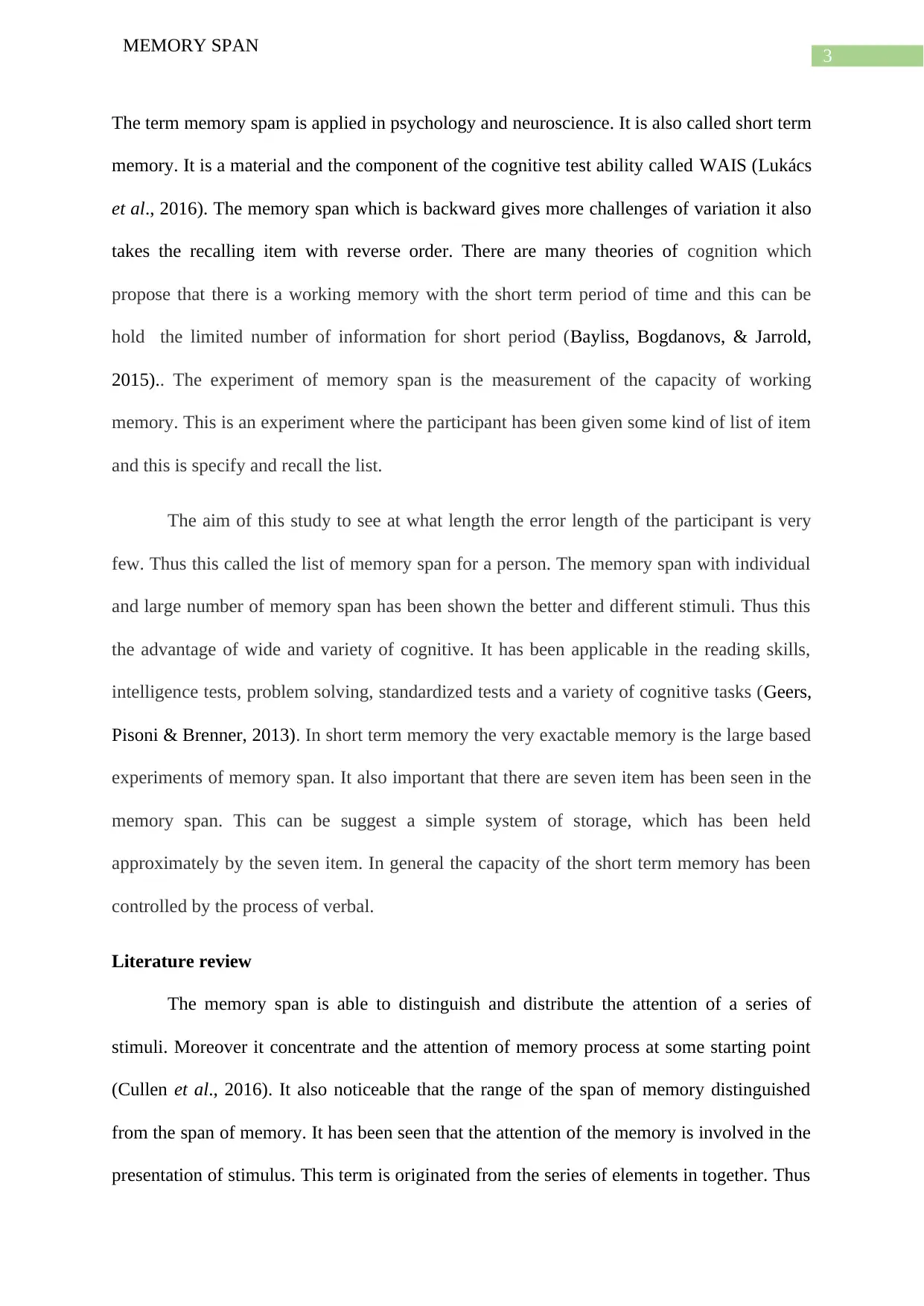
3
MEMORY SPAN
The term memory spam is applied in psychology and neuroscience. It is also called short term
memory. It is a material and the component of the cognitive test ability called WAIS (Lukács
et al., 2016). The memory span which is backward gives more challenges of variation it also
takes the recalling item with reverse order. There are many theories of cognition which
propose that there is a working memory with the short term period of time and this can be
hold the limited number of information for short period (Bayliss, Bogdanovs, & Jarrold,
2015).. The experiment of memory span is the measurement of the capacity of working
memory. This is an experiment where the participant has been given some kind of list of item
and this is specify and recall the list.
The aim of this study to see at what length the error length of the participant is very
few. Thus this called the list of memory span for a person. The memory span with individual
and large number of memory span has been shown the better and different stimuli. Thus this
the advantage of wide and variety of cognitive. It has been applicable in the reading skills,
intelligence tests, problem solving, standardized tests and a variety of cognitive tasks (Geers,
Pisoni & Brenner, 2013). In short term memory the very exactable memory is the large based
experiments of memory span. It also important that there are seven item has been seen in the
memory span. This can be suggest a simple system of storage, which has been held
approximately by the seven item. In general the capacity of the short term memory has been
controlled by the process of verbal.
Literature review
The memory span is able to distinguish and distribute the attention of a series of
stimuli. Moreover it concentrate and the attention of memory process at some starting point
(Cullen et al., 2016). It also noticeable that the range of the span of memory distinguished
from the span of memory. It has been seen that the attention of the memory is involved in the
presentation of stimulus. This term is originated from the series of elements in together. Thus
MEMORY SPAN
The term memory spam is applied in psychology and neuroscience. It is also called short term
memory. It is a material and the component of the cognitive test ability called WAIS (Lukács
et al., 2016). The memory span which is backward gives more challenges of variation it also
takes the recalling item with reverse order. There are many theories of cognition which
propose that there is a working memory with the short term period of time and this can be
hold the limited number of information for short period (Bayliss, Bogdanovs, & Jarrold,
2015).. The experiment of memory span is the measurement of the capacity of working
memory. This is an experiment where the participant has been given some kind of list of item
and this is specify and recall the list.
The aim of this study to see at what length the error length of the participant is very
few. Thus this called the list of memory span for a person. The memory span with individual
and large number of memory span has been shown the better and different stimuli. Thus this
the advantage of wide and variety of cognitive. It has been applicable in the reading skills,
intelligence tests, problem solving, standardized tests and a variety of cognitive tasks (Geers,
Pisoni & Brenner, 2013). In short term memory the very exactable memory is the large based
experiments of memory span. It also important that there are seven item has been seen in the
memory span. This can be suggest a simple system of storage, which has been held
approximately by the seven item. In general the capacity of the short term memory has been
controlled by the process of verbal.
Literature review
The memory span is able to distinguish and distribute the attention of a series of
stimuli. Moreover it concentrate and the attention of memory process at some starting point
(Cullen et al., 2016). It also noticeable that the range of the span of memory distinguished
from the span of memory. It has been seen that the attention of the memory is involved in the
presentation of stimulus. This term is originated from the series of elements in together. Thus
Paraphrase This Document
Need a fresh take? Get an instant paraphrase of this document with our AI Paraphraser
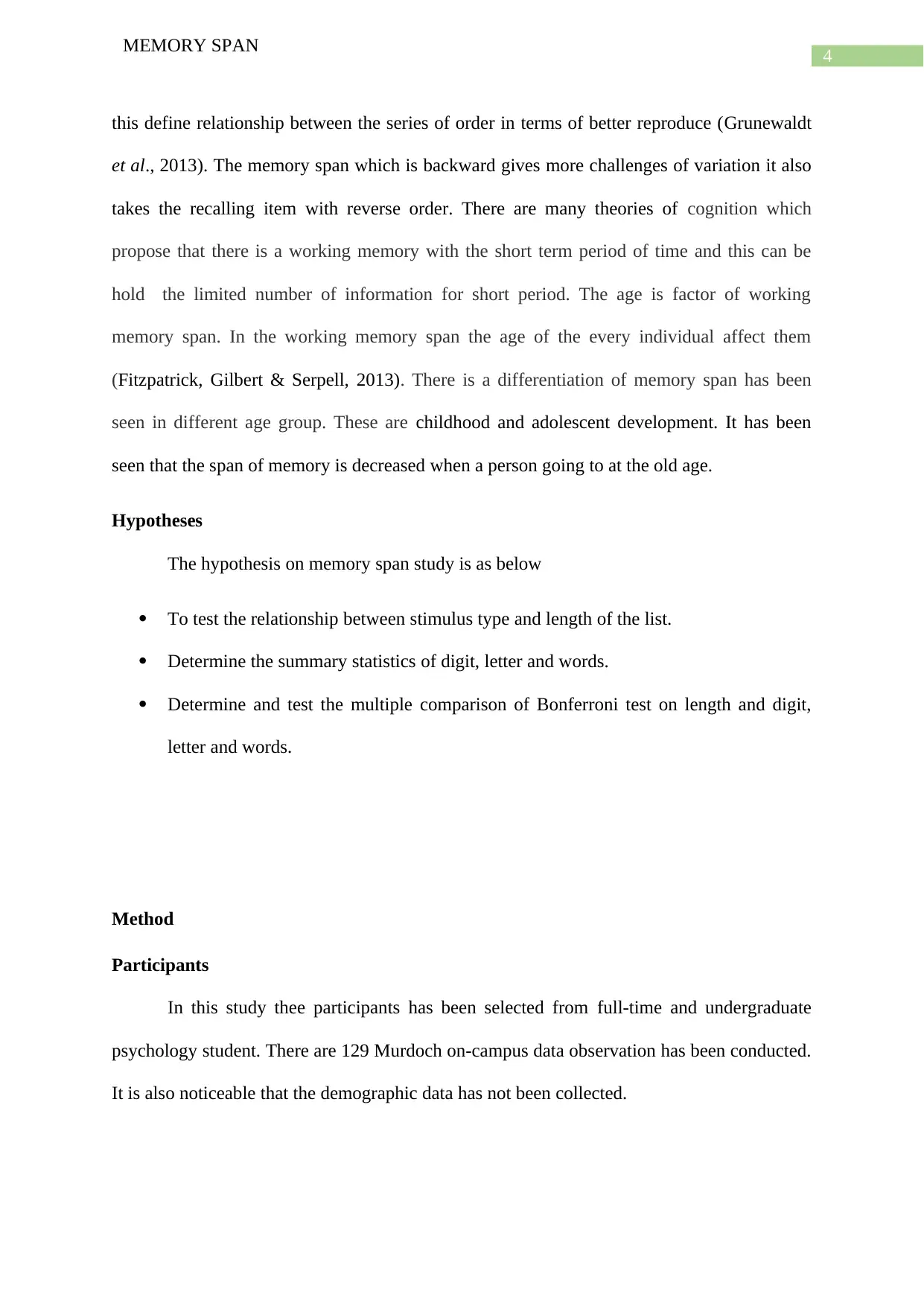
4
MEMORY SPAN
this define relationship between the series of order in terms of better reproduce (Grunewaldt
et al., 2013). The memory span which is backward gives more challenges of variation it also
takes the recalling item with reverse order. There are many theories of cognition which
propose that there is a working memory with the short term period of time and this can be
hold the limited number of information for short period. The age is factor of working
memory span. In the working memory span the age of the every individual affect them
(Fitzpatrick, Gilbert & Serpell, 2013). There is a differentiation of memory span has been
seen in different age group. These are childhood and adolescent development. It has been
seen that the span of memory is decreased when a person going to at the old age.
Hypotheses
The hypothesis on memory span study is as below
To test the relationship between stimulus type and length of the list.
Determine the summary statistics of digit, letter and words.
Determine and test the multiple comparison of Bonferroni test on length and digit,
letter and words.
Method
Participants
In this study thee participants has been selected from full-time and undergraduate
psychology student. There are 129 Murdoch on-campus data observation has been conducted.
It is also noticeable that the demographic data has not been collected.
MEMORY SPAN
this define relationship between the series of order in terms of better reproduce (Grunewaldt
et al., 2013). The memory span which is backward gives more challenges of variation it also
takes the recalling item with reverse order. There are many theories of cognition which
propose that there is a working memory with the short term period of time and this can be
hold the limited number of information for short period. The age is factor of working
memory span. In the working memory span the age of the every individual affect them
(Fitzpatrick, Gilbert & Serpell, 2013). There is a differentiation of memory span has been
seen in different age group. These are childhood and adolescent development. It has been
seen that the span of memory is decreased when a person going to at the old age.
Hypotheses
The hypothesis on memory span study is as below
To test the relationship between stimulus type and length of the list.
Determine the summary statistics of digit, letter and words.
Determine and test the multiple comparison of Bonferroni test on length and digit,
letter and words.
Method
Participants
In this study thee participants has been selected from full-time and undergraduate
psychology student. There are 129 Murdoch on-campus data observation has been conducted.
It is also noticeable that the demographic data has not been collected.

5
MEMORY SPAN
Material and Procedure
The study has been conducted 30 trails and each of stimulus carry 10 trails. Each of
the trail appear a sequence of letter, digit or the words. Each of the trail described a list of
item and which can be presented one at time that is in the random order. After that the item
is recalled at the same order id and this can be presented in the similar way. It has been
noticed that if the list is correct then the length of the list 1 increased. And when the list is not
correct then the length of the list decreased by one. Moreover the data of this study is not
screened for the outliers (Geers et al., 2013). The data which is demographic is not conducted
or recorded. The study has been mainly based upon the raw data of LMS (Oswald et al.,
2015).
In this study the digit, letter or words are the independent variables. The length of the
memory span has been measured or calculated in different ways. At the same time the
dependent variable of this study is length of the last list.
The list which is first carry each item in 3 items long. The largest or the longest list of
has been shown by 10. Hence the maximum score list of item is 10.
Results
Table 1 Summary table
MEMORY SPAN
Material and Procedure
The study has been conducted 30 trails and each of stimulus carry 10 trails. Each of
the trail appear a sequence of letter, digit or the words. Each of the trail described a list of
item and which can be presented one at time that is in the random order. After that the item
is recalled at the same order id and this can be presented in the similar way. It has been
noticed that if the list is correct then the length of the list 1 increased. And when the list is not
correct then the length of the list decreased by one. Moreover the data of this study is not
screened for the outliers (Geers et al., 2013). The data which is demographic is not conducted
or recorded. The study has been mainly based upon the raw data of LMS (Oswald et al.,
2015).
In this study the digit, letter or words are the independent variables. The length of the
memory span has been measured or calculated in different ways. At the same time the
dependent variable of this study is length of the last list.
The list which is first carry each item in 3 items long. The largest or the longest list of
has been shown by 10. Hence the maximum score list of item is 10.
Results
Table 1 Summary table
⊘ This is a preview!⊘
Do you want full access?
Subscribe today to unlock all pages.

Trusted by 1+ million students worldwide
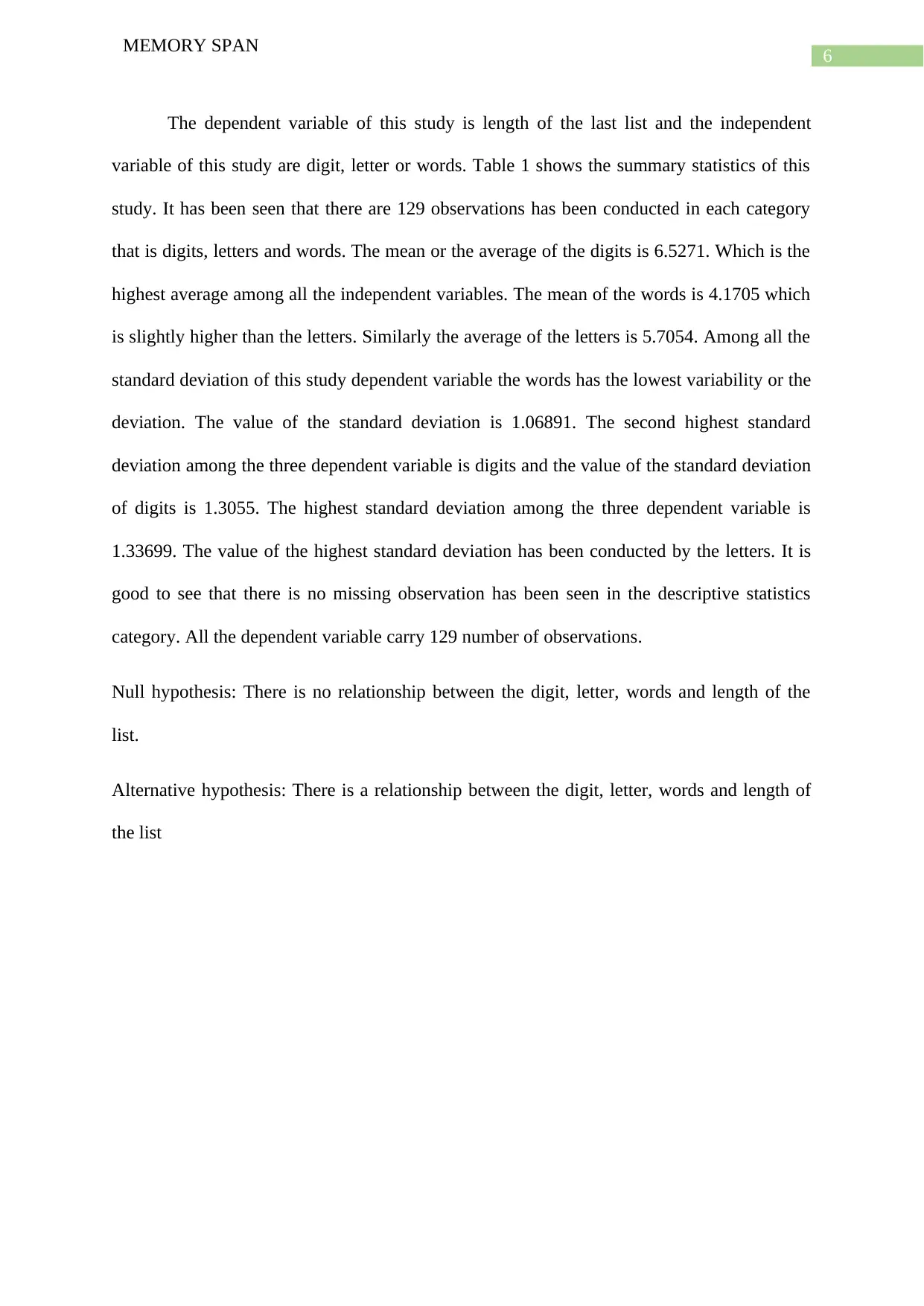
6
MEMORY SPAN
The dependent variable of this study is length of the last list and the independent
variable of this study are digit, letter or words. Table 1 shows the summary statistics of this
study. It has been seen that there are 129 observations has been conducted in each category
that is digits, letters and words. The mean or the average of the digits is 6.5271. Which is the
highest average among all the independent variables. The mean of the words is 4.1705 which
is slightly higher than the letters. Similarly the average of the letters is 5.7054. Among all the
standard deviation of this study dependent variable the words has the lowest variability or the
deviation. The value of the standard deviation is 1.06891. The second highest standard
deviation among the three dependent variable is digits and the value of the standard deviation
of digits is 1.3055. The highest standard deviation among the three dependent variable is
1.33699. The value of the highest standard deviation has been conducted by the letters. It is
good to see that there is no missing observation has been seen in the descriptive statistics
category. All the dependent variable carry 129 number of observations.
Null hypothesis: There is no relationship between the digit, letter, words and length of the
list.
Alternative hypothesis: There is a relationship between the digit, letter, words and length of
the list
MEMORY SPAN
The dependent variable of this study is length of the last list and the independent
variable of this study are digit, letter or words. Table 1 shows the summary statistics of this
study. It has been seen that there are 129 observations has been conducted in each category
that is digits, letters and words. The mean or the average of the digits is 6.5271. Which is the
highest average among all the independent variables. The mean of the words is 4.1705 which
is slightly higher than the letters. Similarly the average of the letters is 5.7054. Among all the
standard deviation of this study dependent variable the words has the lowest variability or the
deviation. The value of the standard deviation is 1.06891. The second highest standard
deviation among the three dependent variable is digits and the value of the standard deviation
of digits is 1.3055. The highest standard deviation among the three dependent variable is
1.33699. The value of the highest standard deviation has been conducted by the letters. It is
good to see that there is no missing observation has been seen in the descriptive statistics
category. All the dependent variable carry 129 number of observations.
Null hypothesis: There is no relationship between the digit, letter, words and length of the
list.
Alternative hypothesis: There is a relationship between the digit, letter, words and length of
the list
Paraphrase This Document
Need a fresh take? Get an instant paraphrase of this document with our AI Paraphraser
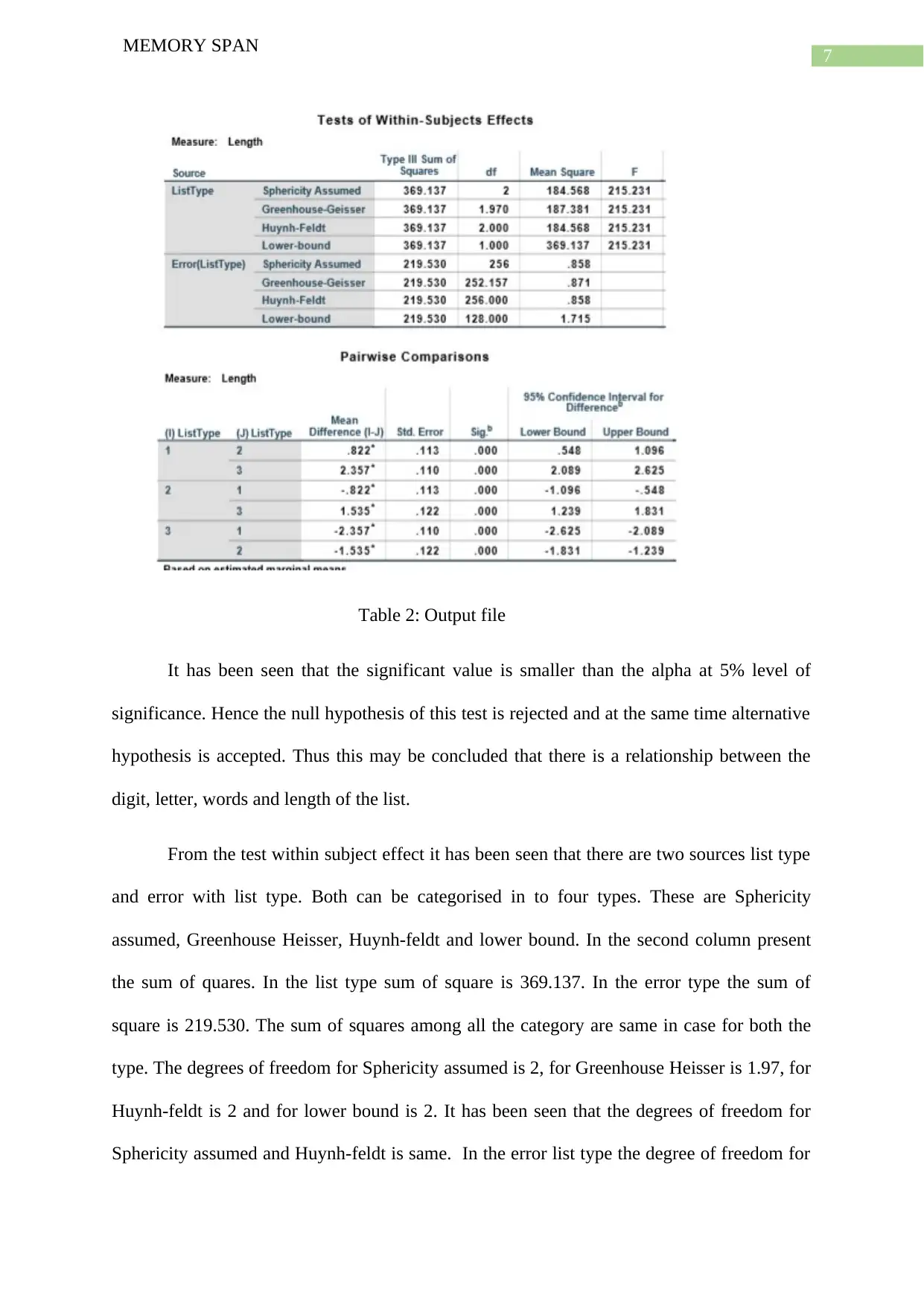
7
MEMORY SPAN
Table 2: Output file
It has been seen that the significant value is smaller than the alpha at 5% level of
significance. Hence the null hypothesis of this test is rejected and at the same time alternative
hypothesis is accepted. Thus this may be concluded that there is a relationship between the
digit, letter, words and length of the list.
From the test within subject effect it has been seen that there are two sources list type
and error with list type. Both can be categorised in to four types. These are Sphericity
assumed, Greenhouse Heisser, Huynh-feldt and lower bound. In the second column present
the sum of quares. In the list type sum of square is 369.137. In the error type the sum of
square is 219.530. The sum of squares among all the category are same in case for both the
type. The degrees of freedom for Sphericity assumed is 2, for Greenhouse Heisser is 1.97, for
Huynh-feldt is 2 and for lower bound is 2. It has been seen that the degrees of freedom for
Sphericity assumed and Huynh-feldt is same. In the error list type the degree of freedom for
MEMORY SPAN
Table 2: Output file
It has been seen that the significant value is smaller than the alpha at 5% level of
significance. Hence the null hypothesis of this test is rejected and at the same time alternative
hypothesis is accepted. Thus this may be concluded that there is a relationship between the
digit, letter, words and length of the list.
From the test within subject effect it has been seen that there are two sources list type
and error with list type. Both can be categorised in to four types. These are Sphericity
assumed, Greenhouse Heisser, Huynh-feldt and lower bound. In the second column present
the sum of quares. In the list type sum of square is 369.137. In the error type the sum of
square is 219.530. The sum of squares among all the category are same in case for both the
type. The degrees of freedom for Sphericity assumed is 2, for Greenhouse Heisser is 1.97, for
Huynh-feldt is 2 and for lower bound is 2. It has been seen that the degrees of freedom for
Sphericity assumed and Huynh-feldt is same. In the error list type the degree of freedom for
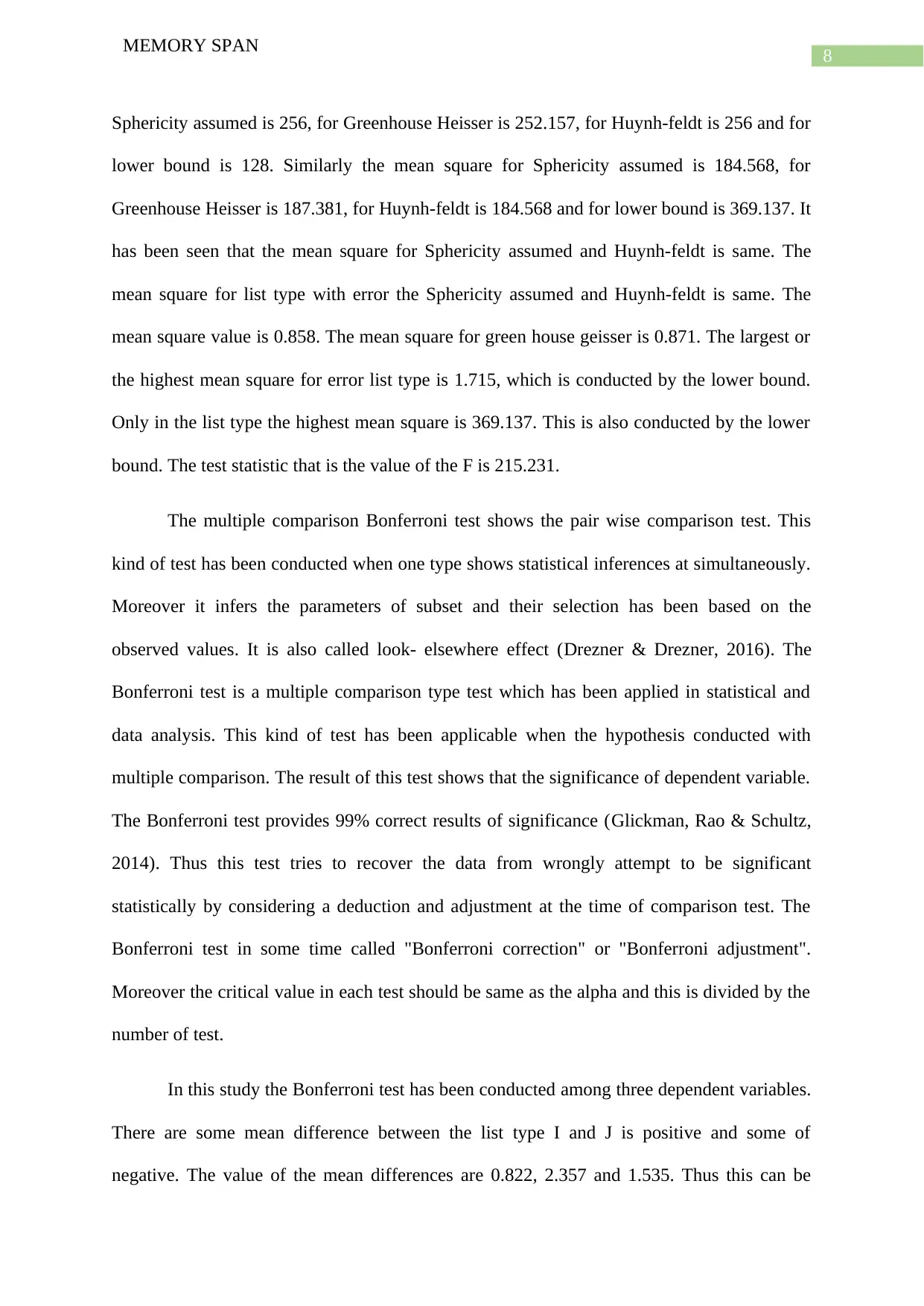
8
MEMORY SPAN
Sphericity assumed is 256, for Greenhouse Heisser is 252.157, for Huynh-feldt is 256 and for
lower bound is 128. Similarly the mean square for Sphericity assumed is 184.568, for
Greenhouse Heisser is 187.381, for Huynh-feldt is 184.568 and for lower bound is 369.137. It
has been seen that the mean square for Sphericity assumed and Huynh-feldt is same. The
mean square for list type with error the Sphericity assumed and Huynh-feldt is same. The
mean square value is 0.858. The mean square for green house geisser is 0.871. The largest or
the highest mean square for error list type is 1.715, which is conducted by the lower bound.
Only in the list type the highest mean square is 369.137. This is also conducted by the lower
bound. The test statistic that is the value of the F is 215.231.
The multiple comparison Bonferroni test shows the pair wise comparison test. This
kind of test has been conducted when one type shows statistical inferences at simultaneously.
Moreover it infers the parameters of subset and their selection has been based on the
observed values. It is also called look- elsewhere effect (Drezner & Drezner, 2016). The
Bonferroni test is a multiple comparison type test which has been applied in statistical and
data analysis. This kind of test has been applicable when the hypothesis conducted with
multiple comparison. The result of this test shows that the significance of dependent variable.
The Bonferroni test provides 99% correct results of significance (Glickman, Rao & Schultz,
2014). Thus this test tries to recover the data from wrongly attempt to be significant
statistically by considering a deduction and adjustment at the time of comparison test. The
Bonferroni test in some time called "Bonferroni correction" or "Bonferroni adjustment".
Moreover the critical value in each test should be same as the alpha and this is divided by the
number of test.
In this study the Bonferroni test has been conducted among three dependent variables.
There are some mean difference between the list type I and J is positive and some of
negative. The value of the mean differences are 0.822, 2.357 and 1.535. Thus this can be
MEMORY SPAN
Sphericity assumed is 256, for Greenhouse Heisser is 252.157, for Huynh-feldt is 256 and for
lower bound is 128. Similarly the mean square for Sphericity assumed is 184.568, for
Greenhouse Heisser is 187.381, for Huynh-feldt is 184.568 and for lower bound is 369.137. It
has been seen that the mean square for Sphericity assumed and Huynh-feldt is same. The
mean square for list type with error the Sphericity assumed and Huynh-feldt is same. The
mean square value is 0.858. The mean square for green house geisser is 0.871. The largest or
the highest mean square for error list type is 1.715, which is conducted by the lower bound.
Only in the list type the highest mean square is 369.137. This is also conducted by the lower
bound. The test statistic that is the value of the F is 215.231.
The multiple comparison Bonferroni test shows the pair wise comparison test. This
kind of test has been conducted when one type shows statistical inferences at simultaneously.
Moreover it infers the parameters of subset and their selection has been based on the
observed values. It is also called look- elsewhere effect (Drezner & Drezner, 2016). The
Bonferroni test is a multiple comparison type test which has been applied in statistical and
data analysis. This kind of test has been applicable when the hypothesis conducted with
multiple comparison. The result of this test shows that the significance of dependent variable.
The Bonferroni test provides 99% correct results of significance (Glickman, Rao & Schultz,
2014). Thus this test tries to recover the data from wrongly attempt to be significant
statistically by considering a deduction and adjustment at the time of comparison test. The
Bonferroni test in some time called "Bonferroni correction" or "Bonferroni adjustment".
Moreover the critical value in each test should be same as the alpha and this is divided by the
number of test.
In this study the Bonferroni test has been conducted among three dependent variables.
There are some mean difference between the list type I and J is positive and some of
negative. The value of the mean differences are 0.822, 2.357 and 1.535. Thus this can be
⊘ This is a preview!⊘
Do you want full access?
Subscribe today to unlock all pages.

Trusted by 1+ million students worldwide
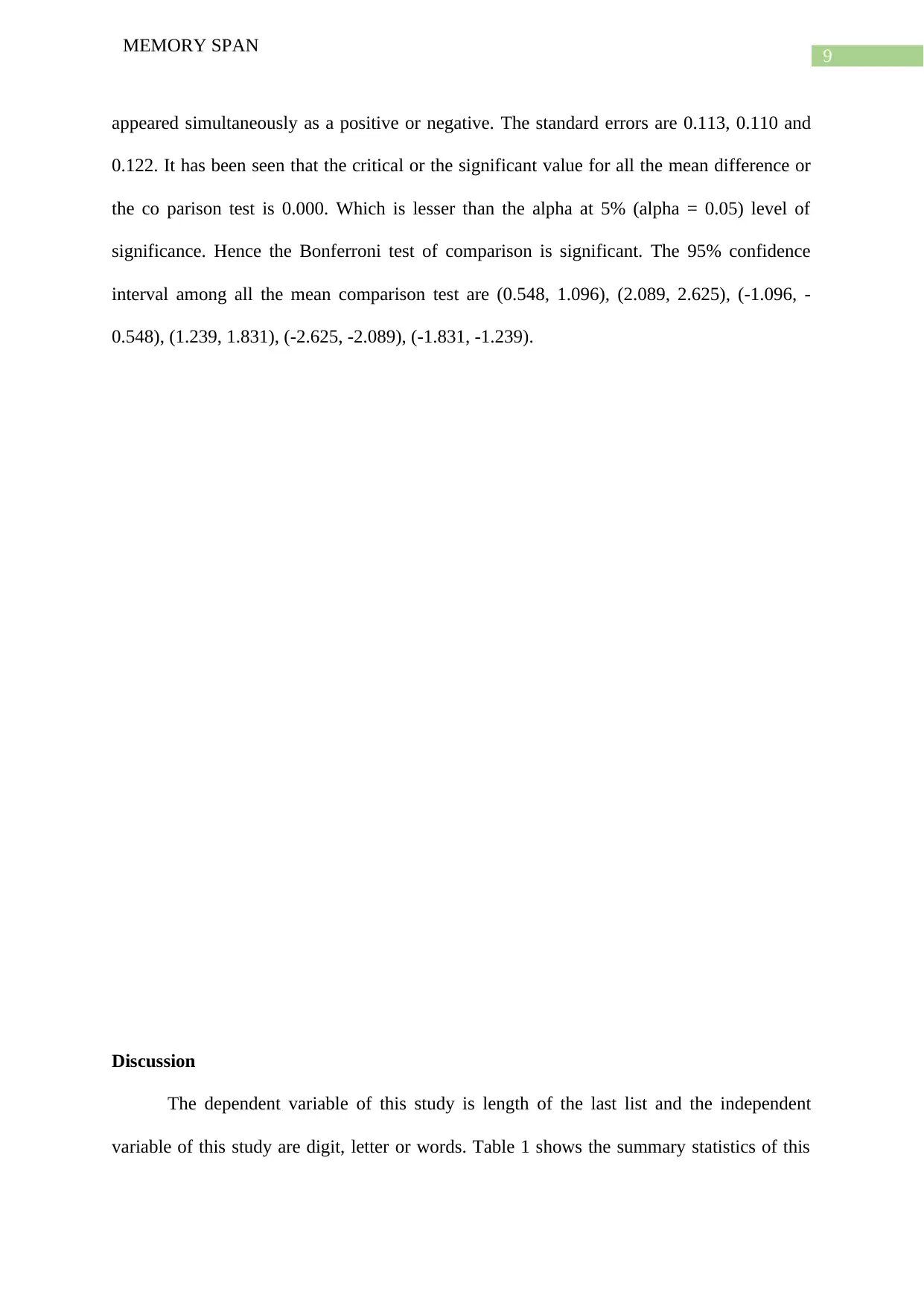
9
MEMORY SPAN
appeared simultaneously as a positive or negative. The standard errors are 0.113, 0.110 and
0.122. It has been seen that the critical or the significant value for all the mean difference or
the co parison test is 0.000. Which is lesser than the alpha at 5% (alpha = 0.05) level of
significance. Hence the Bonferroni test of comparison is significant. The 95% confidence
interval among all the mean comparison test are (0.548, 1.096), (2.089, 2.625), (-1.096, -
0.548), (1.239, 1.831), (-2.625, -2.089), (-1.831, -1.239).
Discussion
The dependent variable of this study is length of the last list and the independent
variable of this study are digit, letter or words. Table 1 shows the summary statistics of this
MEMORY SPAN
appeared simultaneously as a positive or negative. The standard errors are 0.113, 0.110 and
0.122. It has been seen that the critical or the significant value for all the mean difference or
the co parison test is 0.000. Which is lesser than the alpha at 5% (alpha = 0.05) level of
significance. Hence the Bonferroni test of comparison is significant. The 95% confidence
interval among all the mean comparison test are (0.548, 1.096), (2.089, 2.625), (-1.096, -
0.548), (1.239, 1.831), (-2.625, -2.089), (-1.831, -1.239).
Discussion
The dependent variable of this study is length of the last list and the independent
variable of this study are digit, letter or words. Table 1 shows the summary statistics of this
Paraphrase This Document
Need a fresh take? Get an instant paraphrase of this document with our AI Paraphraser
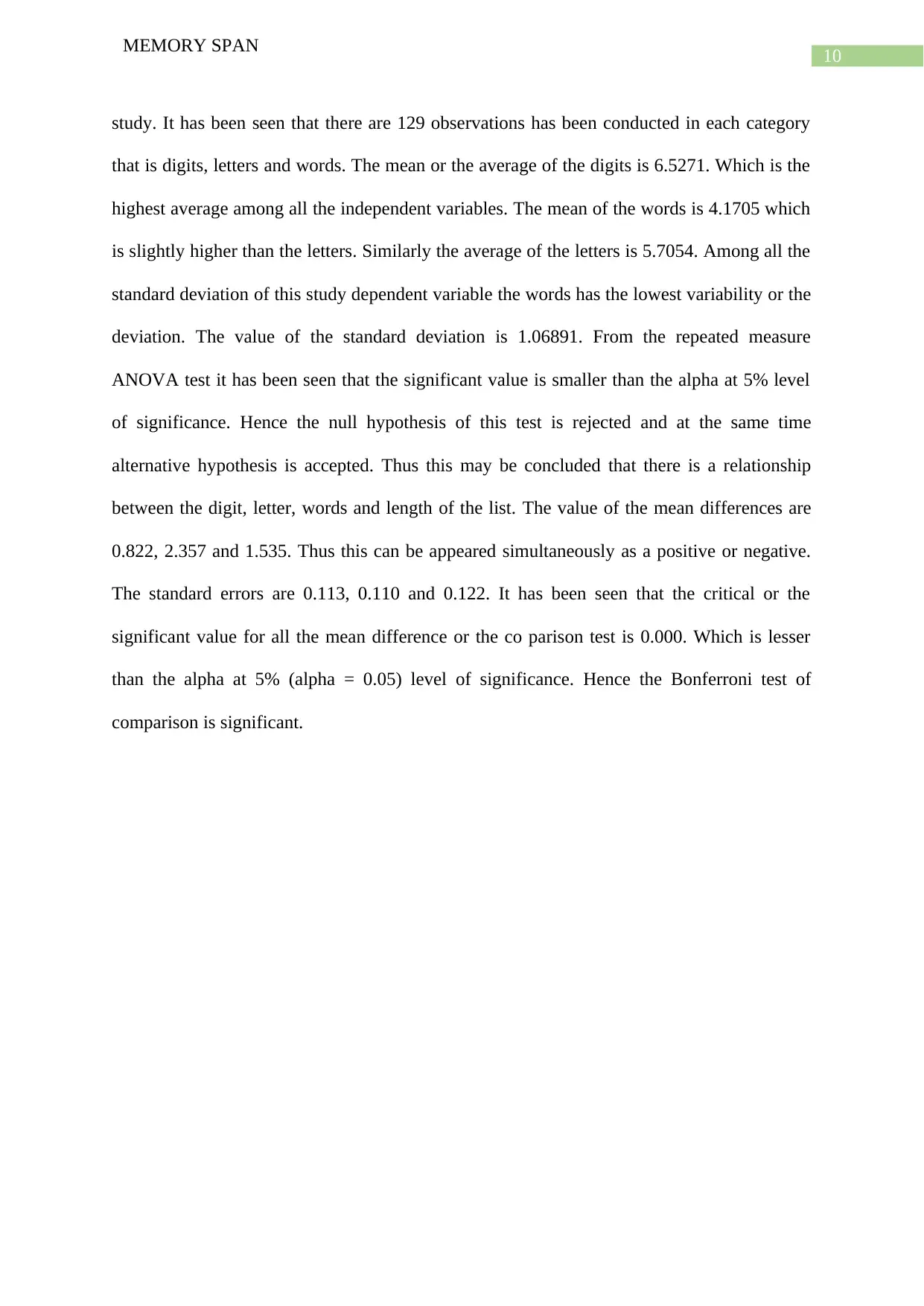
10
MEMORY SPAN
study. It has been seen that there are 129 observations has been conducted in each category
that is digits, letters and words. The mean or the average of the digits is 6.5271. Which is the
highest average among all the independent variables. The mean of the words is 4.1705 which
is slightly higher than the letters. Similarly the average of the letters is 5.7054. Among all the
standard deviation of this study dependent variable the words has the lowest variability or the
deviation. The value of the standard deviation is 1.06891. From the repeated measure
ANOVA test it has been seen that the significant value is smaller than the alpha at 5% level
of significance. Hence the null hypothesis of this test is rejected and at the same time
alternative hypothesis is accepted. Thus this may be concluded that there is a relationship
between the digit, letter, words and length of the list. The value of the mean differences are
0.822, 2.357 and 1.535. Thus this can be appeared simultaneously as a positive or negative.
The standard errors are 0.113, 0.110 and 0.122. It has been seen that the critical or the
significant value for all the mean difference or the co parison test is 0.000. Which is lesser
than the alpha at 5% (alpha = 0.05) level of significance. Hence the Bonferroni test of
comparison is significant.
MEMORY SPAN
study. It has been seen that there are 129 observations has been conducted in each category
that is digits, letters and words. The mean or the average of the digits is 6.5271. Which is the
highest average among all the independent variables. The mean of the words is 4.1705 which
is slightly higher than the letters. Similarly the average of the letters is 5.7054. Among all the
standard deviation of this study dependent variable the words has the lowest variability or the
deviation. The value of the standard deviation is 1.06891. From the repeated measure
ANOVA test it has been seen that the significant value is smaller than the alpha at 5% level
of significance. Hence the null hypothesis of this test is rejected and at the same time
alternative hypothesis is accepted. Thus this may be concluded that there is a relationship
between the digit, letter, words and length of the list. The value of the mean differences are
0.822, 2.357 and 1.535. Thus this can be appeared simultaneously as a positive or negative.
The standard errors are 0.113, 0.110 and 0.122. It has been seen that the critical or the
significant value for all the mean difference or the co parison test is 0.000. Which is lesser
than the alpha at 5% (alpha = 0.05) level of significance. Hence the Bonferroni test of
comparison is significant.
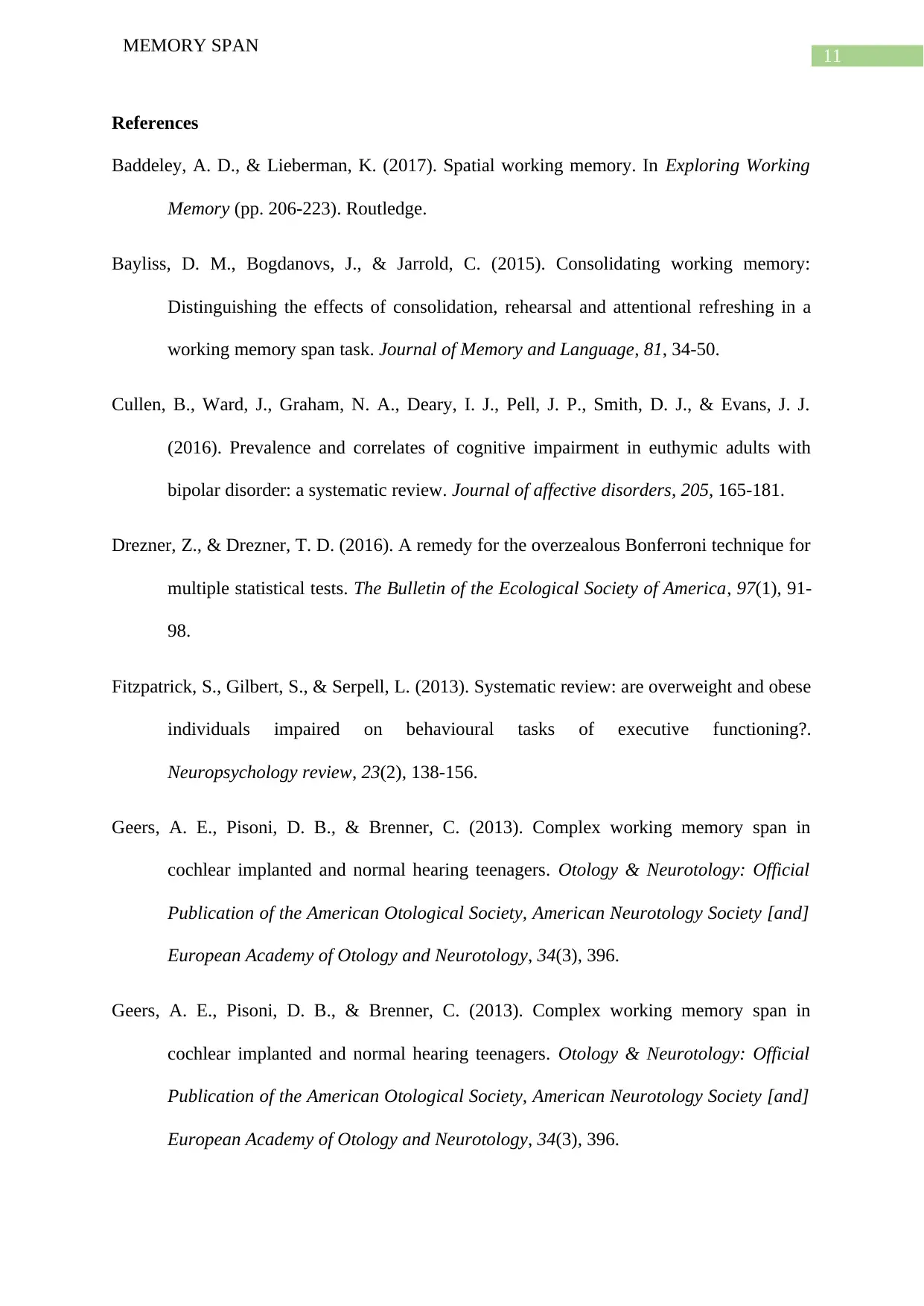
11
MEMORY SPAN
References
Baddeley, A. D., & Lieberman, K. (2017). Spatial working memory. In Exploring Working
Memory (pp. 206-223). Routledge.
Bayliss, D. M., Bogdanovs, J., & Jarrold, C. (2015). Consolidating working memory:
Distinguishing the effects of consolidation, rehearsal and attentional refreshing in a
working memory span task. Journal of Memory and Language, 81, 34-50.
Cullen, B., Ward, J., Graham, N. A., Deary, I. J., Pell, J. P., Smith, D. J., & Evans, J. J.
(2016). Prevalence and correlates of cognitive impairment in euthymic adults with
bipolar disorder: a systematic review. Journal of affective disorders, 205, 165-181.
Drezner, Z., & Drezner, T. D. (2016). A remedy for the overzealous Bonferroni technique for
multiple statistical tests. The Bulletin of the Ecological Society of America, 97(1), 91-
98.
Fitzpatrick, S., Gilbert, S., & Serpell, L. (2013). Systematic review: are overweight and obese
individuals impaired on behavioural tasks of executive functioning?.
Neuropsychology review, 23(2), 138-156.
Geers, A. E., Pisoni, D. B., & Brenner, C. (2013). Complex working memory span in
cochlear implanted and normal hearing teenagers. Otology & Neurotology: Official
Publication of the American Otological Society, American Neurotology Society [and]
European Academy of Otology and Neurotology, 34(3), 396.
Geers, A. E., Pisoni, D. B., & Brenner, C. (2013). Complex working memory span in
cochlear implanted and normal hearing teenagers. Otology & Neurotology: Official
Publication of the American Otological Society, American Neurotology Society [and]
European Academy of Otology and Neurotology, 34(3), 396.
MEMORY SPAN
References
Baddeley, A. D., & Lieberman, K. (2017). Spatial working memory. In Exploring Working
Memory (pp. 206-223). Routledge.
Bayliss, D. M., Bogdanovs, J., & Jarrold, C. (2015). Consolidating working memory:
Distinguishing the effects of consolidation, rehearsal and attentional refreshing in a
working memory span task. Journal of Memory and Language, 81, 34-50.
Cullen, B., Ward, J., Graham, N. A., Deary, I. J., Pell, J. P., Smith, D. J., & Evans, J. J.
(2016). Prevalence and correlates of cognitive impairment in euthymic adults with
bipolar disorder: a systematic review. Journal of affective disorders, 205, 165-181.
Drezner, Z., & Drezner, T. D. (2016). A remedy for the overzealous Bonferroni technique for
multiple statistical tests. The Bulletin of the Ecological Society of America, 97(1), 91-
98.
Fitzpatrick, S., Gilbert, S., & Serpell, L. (2013). Systematic review: are overweight and obese
individuals impaired on behavioural tasks of executive functioning?.
Neuropsychology review, 23(2), 138-156.
Geers, A. E., Pisoni, D. B., & Brenner, C. (2013). Complex working memory span in
cochlear implanted and normal hearing teenagers. Otology & Neurotology: Official
Publication of the American Otological Society, American Neurotology Society [and]
European Academy of Otology and Neurotology, 34(3), 396.
Geers, A. E., Pisoni, D. B., & Brenner, C. (2013). Complex working memory span in
cochlear implanted and normal hearing teenagers. Otology & Neurotology: Official
Publication of the American Otological Society, American Neurotology Society [and]
European Academy of Otology and Neurotology, 34(3), 396.
⊘ This is a preview!⊘
Do you want full access?
Subscribe today to unlock all pages.

Trusted by 1+ million students worldwide
1 out of 13
Related Documents
Your All-in-One AI-Powered Toolkit for Academic Success.
+13062052269
info@desklib.com
Available 24*7 on WhatsApp / Email
![[object Object]](/_next/static/media/star-bottom.7253800d.svg)
Unlock your academic potential
Copyright © 2020–2025 A2Z Services. All Rights Reserved. Developed and managed by ZUCOL.




